Wishing you a holiday that’s merry and bright!
Christmas card (undated) from the Zaner-Bloser, Inc. / Sonya Bloser Monroe Penmanship Collection
Christmas card (undated) from the Zaner-Bloser, Inc. / Sonya Bloser Monroe Penmanship Collection

Last week at DPLAFest in Washington, DC, executive director Dan Cohen announced that the Digital Public Library of America had grown in its third year to include more than 13 million records. We’re proud to announce that 12,876 of those records were contributed by the University of Scranton Weinberg Memorial Library.
Launched in 2013, DPLA is a digital platform and network that brings together descriptive information for rare and unique digital materials from more than 1,900 libraries, archives, and museums across the country. It’s a portal to the treasures of American cultural heritage, from digitized photographs, films, documents, and objects to born digital ebooks, video, and images. All of these materials are freely available on the web for use by researchers, students, teachers, genealogists, and the general public.
We’ve been building digital collections at the University of Scranton since 2008, and nearly all of our materials are already publicly available on our website at www.scranton.edu/library/digitalcollections (some items are restricted due to copyright, privacy, or donor request). So why participate in DPLA?
DPLA doesn’t host digital materials – they’re all stored and made accessible by contributing institutions like us, so it’s still our job to keep digitizing, describing, preserving, and publishing digital items. What DPLA does is make these materials discoverable and usable in entirely new and exciting ways. Metadata records (descriptive information) that we send to DPLA are aggregated into a stream of open data that can be used by software developers and others to create new tools or visualizations. Two of our favorites are the DPLA Visual Search Prototype and Culture Collage, which offer more visual interfaces for browsing and sorting through search results.
(We also get a kick out of Term vs. Term, which compares the number of DPLA search results for two phrases. You know, like Scranton vs. Wilkes-Barre. Just saying.)
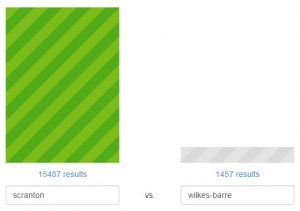 Perhaps most importantly, DPLA allows for unified access, which is important both for 1) users who don’t necessarily know what institution will have the records they’re looking for and 2) collections that have been physically fragmented across different institutions.
Perhaps most importantly, DPLA allows for unified access, which is important both for 1) users who don’t necessarily know what institution will have the records they’re looking for and 2) collections that have been physically fragmented across different institutions.
An example of the former might be a genealogist looking for information about family members from Scranton. Using DPLA, they can find not only relevant materials in our collections (like our yearbooks and Aquinas issues, which are excellent sources for information about our alumni) but they’ll also stumble across photographs, manuscripts, and books from the Lackawanna Valley Digital Archives, postcards from the Boston Public Library, stereographs and menus from the New York Public Library, and genealogical books from the Library of Congress.
An example of the latter is the Horace G. Healey Collection, an impressive set of 19th century penmanship and calligraphy. Half of the collection is available here on campus in our McHugh Special Collections (as part of our Zaner-Bloser Penmanship Collection), but the other half is at the New York Public Library. In DPLA, images of the artwork are reunited as they are digitized.
Our participation in DPLA has been in the works for almost two years. DPLA is unable to accept metadata records directly from individual libraries – there are just too many potential contributors! – so almost all of its data passes through nodes called Service Hubs. Most service hubs are established at a state or regional level, and Pennsylvania didn’t have one when DPLA first launched. Beginning in August 2014, a group of Pennsylvania cultural heritage institutions got together to discuss how best to collaborate on digital collections in the state. After a year of planning, coordination, and tons of work, the PA Digital Partnership was approved as a DPLA Service Hub in August 2015. On April 13, 2016, data from the PA Digital Partnership went live in DPLA, with 131, 651 records from 19 contributing Pennsylvania institutions.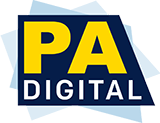 We’re incredibly proud to be part of DPLA and the PA Digital Partnership, and we’re thrilled to see our digital collections be more accessible and discoverable than ever. Congratulations to all our PA Digital colleagues, and happy searching to all!
We’re incredibly proud to be part of DPLA and the PA Digital Partnership, and we’re thrilled to see our digital collections be more accessible and discoverable than ever. Congratulations to all our PA Digital colleagues, and happy searching to all!
 This Saturday is Charter Day, Scranton’s celebration of the 150th anniversary of its incorporation as a city. There will be lots of events going on all day, but here’s another festive option for creative Scrantonians: Charter Day Coloring Pages!
This Saturday is Charter Day, Scranton’s celebration of the 150th anniversary of its incorporation as a city. There will be lots of events going on all day, but here’s another festive option for creative Scrantonians: Charter Day Coloring Pages!
These Coloring Pages were a collaborative effort between the Lackawanna Historical Society, the Lackawanna Valley Digital Archives, the Leadership Lackawanna #HistoricScranton team, and the University of Scranton Weinberg Memorial Library (we had way too much fun working on our Local History Coloring Book back in February and couldn’t resist coming back for more!).
The pages feature images of the city and its past. Leadership Lackawanna’s #HistoricScranton coloring pages, created as part of a current class project with the Historical Architectural Review Board, highlight historic buildings and architecture. The remaining pages hold digitized drawings from local history collections housed at LHS, the Scranton Public Library, and our own University Archives and Helen Gallagher McHugh Special Collections. (We also included a few images from books digitized by other libraries that are now in the public domain.) Each digitized image is accompanied by a citation describing the image and its source.
LHS will be printing out pages for coloring contests to be held throughout this week, but you can also download a digital copy and print out your own. Happy coloring, and happy birthday Scranton!
Many thanks to all our partners, and extra special thanks to our Weinberg Memorial Library students and staffers who helped with selecting images and making them coloring-friendly!
The library, archives, and museum world is abuzz this week with #ColorOurCollections, a weeklong cultural heritage coloring fest dreamed up by the New York Academy of Medicine and the Biodiversity Heritage Library.
As coloring fans ourselves, we couldn’t help but toss our hat into the ring. Earlier this week, we shared a University Archives coloring book and a Local History coloring book, but we’ve saved the best for last. Today’s coloring book features some gorgeous penmanship from the Zaner-Bloser, Inc. / Sonya Bloser Monroe Collection and the Horace G. Healey Collection, both preserved in our Helen Gallagher McHugh Special Collections. Featured at the end are works by Scranton’s own master penman P. W. Costello.
Penmanship Coloring Book (PDF)
The pages in the book were created using images from the Library’s digital collections, which were digitized from original artwork, publications, and albums.
Please note: We’ve edited the images to increase their “colorability.” In many cases, this process obscured some of the incredible detail and shading in the original work. We encourage you to explore the master scans (and the many, many other items in our collections!) at www.scranton.edu/library/zanerbloser.
We hope you enjoy our book, and we can’t wait to see what colors you bring to our collections!
The library, archives, and museum world is abuzz this week with #ColorOurCollections, a weeklong cultural heritage coloring fest dreamed up by the New York Academy of Medicine and the Biodiversity Heritage Library.
As coloring fans ourselves, we couldn’t help but toss our hat into the ring. We have a few small coloring books headed your way this week, and here’s the first!
University of Scranton University Archives Coloring Book (PDF)
All of the pages in the book were created using images from the Library’s digital collections, most of which were digitized from original drawings, photographs, and publications from our University Archives.
We hope you enjoy our book, and we can’t wait to see what colors you bring to our collections!

 As part of the City of Scranton’s yearlong 150th Anniversary celebration, the Weinberg Memorial Library hosted our very first Scanathon this weekend. In collaboration with the University’s Department of History and the student-run Royals Historical Society, along with community partners the Lackawanna Historical Society and the Scranton Public Library, we set out to digitize materials from the Scranton Family Papers Collection.
As part of the City of Scranton’s yearlong 150th Anniversary celebration, the Weinberg Memorial Library hosted our very first Scanathon this weekend. In collaboration with the University’s Department of History and the student-run Royals Historical Society, along with community partners the Lackawanna Historical Society and the Scranton Public Library, we set out to digitize materials from the Scranton Family Papers Collection.
Materials
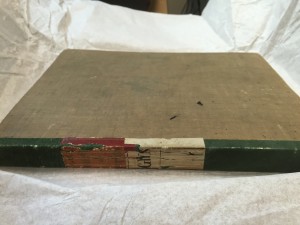
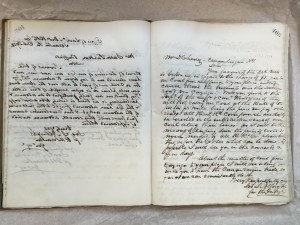
The Lackawanna Historical Society’s Scranton Family Papers collection includes 19 bound volumes of over 9,000 letters written by George W. Scranton, Joseph Hand Scranton, and William Walker Scranton, dating from 1850 to 1917. The Scranton Family collection is quite large; the full set has over 11,000 pages. Our goal for this Scanathon was to completely digitize the first two volumes of the collection: the George W. Scranton Papers (approximately 414 letters, 625 pages), which cover the time period June 1850 through June 1854.
The Historical Society also loaned us a box of loose correspondence from the Scranton Family, with letters to and from Joseph H. Scranton, Seldon T. Scranton, George W. Scranton, and William W. Scranton, dating from 1841 through 1874.
Participants
We knew we’d need a lot of help, and the History Department stepped up. Faculty member Dr. Adam Pratt came and brought students from his HIST140: Craft of the Historian course. The Royals Historical Society also volunteered in force. In total, more than 30 students came to the Library to work three-hour shifts. Staff members from the Lackawanna Historical Society and Scranton Public Library joined in, working side by side with our students.
Digitization
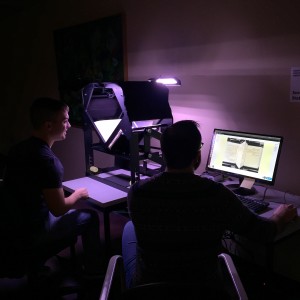
Bound volumes are always difficult to scan. Luckily, we got some extra help from the State Library of Pennsylvania, which loaned us their brand new table top Scribe Station for the weekend. The Scribe Station is part of a new initiative to support the digitization of important cultural heritage materials in the state of Pennsylvania, and we were the first to sign up! We also used the Library’s flatbed scanners to digitize the loose correspondence.
The result? Success! Not only did we completely digitize both George W. Scranton volumes, we also made a serious dent in the loose letters. Over the course of the weekend, volunteers created 1,608 digitized images (over 20 GB).
Why digitize? The most important reason is access. Up until now, the George W. Scranton volumes have only been accessible to researchers visiting the Lackawanna Historical Society in person. Digitization and online publication will make the letters much more accessible (and full-text searchable!) to historians, students, genealogists, the citizens of Scranton, and any other interested members of the public. Digitization also helps to protect and preserve the papers, which are in rather fragile condition – most researchers will be able to use the digital versions, reducing the wear and tear and decreasing the risk of damage to the original physical volumes.
Description and Transcription
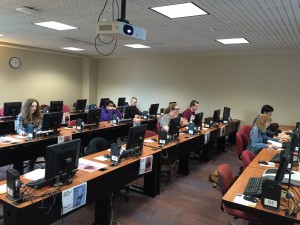
The Scanathon wasn’t just about scanning, though. In order for digitized images to be discoverable and useful, they need to be described. In between shifts on the scanners, our volunteers captured descriptive information (called metadata) about the letters and prepared a spreadsheet that we can use to prepare the digitized images for online publication. Lackawanna Historical Society volunteers had previously prepared transcriptions of the George W. Scranton volumes (thank you!!), which our volunteers copied into our metadata spreadsheets. We also got a start on transcribing the loose correspondence — our students really stepped up to the challenge of reading scrawling, 19th-century cursive.
What’s Next?
The Scanathon may be over, but our work isn’t done quite yet. In the next few weeks, Scranton Public Library and University of Scranton Library faculty and staff will match up the digitized letters with the descriptions and transcriptions and publish them online in the Lackawanna Valley Digital Archives. (To get a sense of how they will look, take a look at this letter that we digitized a few years ago as part of a collaborative Civil War digital history project.)
Update: Full volumes (sans transcriptions) are live on Internet Archive!! (Volume 1 – Volume 2)
Update: All digitized letters and documents are live in the Scranton Family Papers digital collection!
Early next year, the letters will also be discoverable in the Digital Public Library of America (DPLA) via the brand new Pennsylvania Digital Collections Project service hub. The University of Scranton and the Scranton Public Library are both founding members and active participants in this statewide initiative, so we’re thrilled to be able to give this new digital collection the exposure it deserves.
Acknowledgements
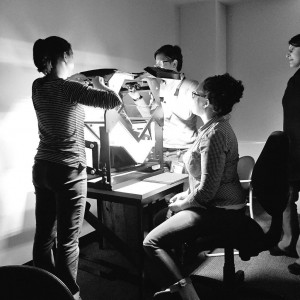
This was our first Scanathon, and it was certainly a learning experience. Perhaps the most important lesson learned was how wonderful it is to have help and support from so many people. Our deepest thanks go out to: Weinberg Memorial Library faculty and staff (especially Sam Davis, Sheli McHugh, Mary Kovalcin, Sharon Finnerty, Kym Fetsko, Kevin Kocur, Ian O’Hara, and work study Kate Reilly), History Department faculty and students (especially Dr. Adam Pratt and RHS president Julia Frakes), Lackawanna Historical Society staff and volunteers (especially Sarah Piccini and the Martin Family), Scranton Public Library staff (especially Scott Thomas, Martina Soden, Sylvia Orner, and Elizabeth Davis), and the State Library of Pennsylvania (especially Alice Lubrecht and Bill Fee). We’ll scan with you any day!
 Tomorrow morning at 9:15 am, the City of Scranton will kick off its year-long Sesquicentennial Anniversary Celebration. Scranton was incorporated as a city on April 23, 1866, so next spring (April 23, 2016) will be the city’s 150th birthday.
Tomorrow morning at 9:15 am, the City of Scranton will kick off its year-long Sesquicentennial Anniversary Celebration. Scranton was incorporated as a city on April 23, 1866, so next spring (April 23, 2016) will be the city’s 150th birthday.
While the University of Scranton itself wasn’t around back at the very beginning (founded in 1888, we just celebrated our 125th anniversary in 2013-2014), we’re proud of the close ‘town and gown’ relationship we’ve had with the city of Scranton throughout our shared history.
Here at the Weinberg Memorial Library, we’re looking forward to joining in the fun throughout the anniversary year. Beginning in May, each month of the City celebration will highlight a decade (or two) in the city’s history, and here on our Library blog we’ll be highlighting how the University grew alongside the city during that time.
Our University Archives and Helen Gallagher McHugh Special Collections include many rare and unique resources related to the history of the City of Scranton, its residents, and its major institutions. For example, the Library holds the records of the International Correspondence Schools of Scranton – and in the fall, we’ll be exhibiting materials from this collection in celebration of the 125th anniversary of ICS (now known as Penn Foster), which was founded in 1891.
We’ve been working on digitizing archival and special collections materials and making them publicly available for searching and browsing in our digital collections, but there’s always more to do. We’re currently tossing around new ideas for increasing public, digital access to local history materials with some of our friends on campus (the History and Communication Departments, Royals’ Historical Society, Hope Horn Gallery, and Community Relations) and in the community (the Lackawanna Historical Society, the Everhart Museum, Scranton Public Library/Lackawanna Valley Digital Archives, and Marywood University). More to come on this as our plans develop!
At the state level, we’re collaborating with other academic and public libraries on a broad initiative to establish a Pennsylvania service hub for the Digital Public Library of America, which will make Pennsylvania history and cultural heritage more accessible and discoverable to students, teachers, genealogists, historians, scholars, and others in our communities and around the world.
So happy birthday, Scranton! Let’s get this party started.

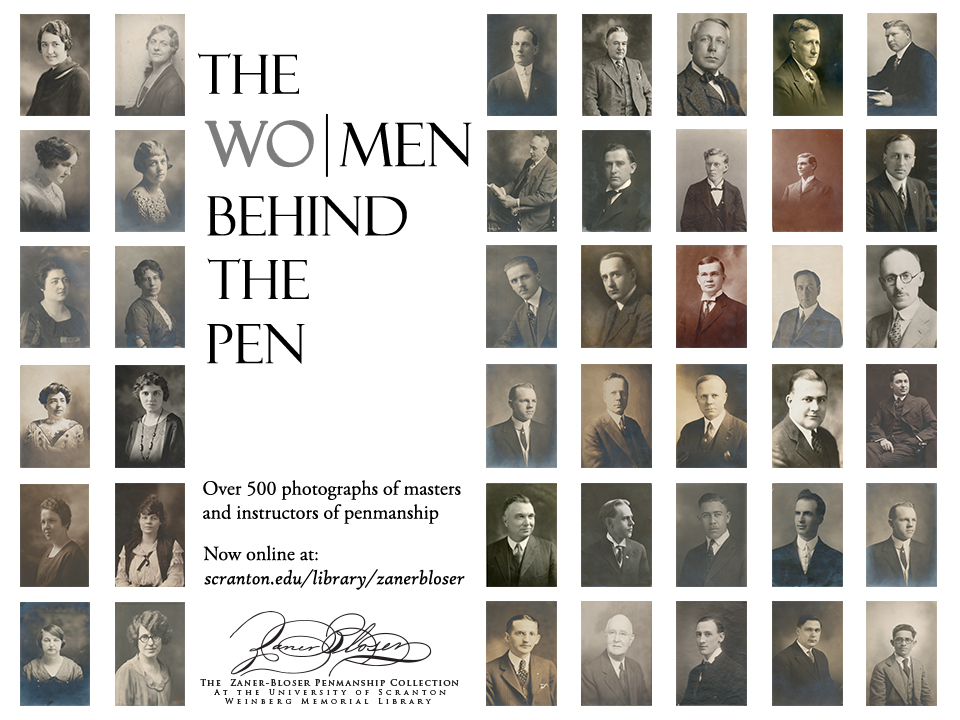 One of the most highly prized jewels in our Helen Gallagher McHugh Special Collections is the Zaner-Bloser Penmanship Collection, one of the most extensive collections of American ornamental penmanship from the late 19th and early 20th centuries. Over time, we’ve been digitizing parts of the Zaner-Bloser Collection to make it more accessible to researchers and penmanship enthusiasts around the world.
One of the most highly prized jewels in our Helen Gallagher McHugh Special Collections is the Zaner-Bloser Penmanship Collection, one of the most extensive collections of American ornamental penmanship from the late 19th and early 20th centuries. Over time, we’ve been digitizing parts of the Zaner-Bloser Collection to make it more accessible to researchers and penmanship enthusiasts around the world.
We’re now happy to announce that more than 500 photographs of celebrated masters and instructors of penmanship from the Zaner-Bloser Collection are now publicly available online. The photographs (96 portraits of women and 453 of men) were gathered by Zaner-Bloser for publication in penmanship journals like the Business Educator. Few of the photographs are dated, but we estimate that most of them were taken between the early 1900s and early 1940s.
Some of the photographs are portraits of celebrated master penmen, including several members of Michael Sull‘s Penman’s Hall of Fame. Others are lesser known teachers and instructors, some of whom we weren’t able to identify (please contact us if you recognize them!).
None of these photographs would be online today were it not for Thomas W. Costello, who spent many hours carefully digitizing the portraits for us. Tom’s great-grandfather is Scranton’s own master penman P. W. Costello, who has three portraits in the collection. Tom described the photograph collection as a “wonderful, well-deserved tribute to the masters and many of the dedicated unsung heroes who worked under the radar teaching penmanship.” We couldn’t say it better ourselves. Thank you, Tom, for bringing the men and women behind the pen into the spotlight.
The University of Scranton seeks an Archival and Special Collections Cataloging and Metadata Specialist (part-time). The Archival and Special Collections Cataloging and Metadata Specialist supports the work of the Special Collections Librarian, the Digital Services Librarian, and the Cataloging and Metadata Librarian, in the coordinated cataloging, description, and record-keeping necessary to the preservation, accessibility, and findability of University Archives and Special Collections materials. Working across varied Library information systems, this position creates, maintains, and enhances descriptive, administrative, structural, and preservation metadata of various types for materials of diverse formats.
Qualifications: A bachelor’s degree required along with broad subject knowledge. A graduate degree in archives, public history, digital humanities or an ALA-accredited master’s degree in library or information science is preferred.
Required knowledge, skills, and abilities include: a knowledge of library and archival procedures; the ability to perform repetitive, detail-oriented tasks and work independently in an isolated environment; and excellent record-keeping, written, oral and instructional skills.
The candidate must be able to lift at least 30 lbs., climb a step-stool, and be tolerant of different environmental conditions. A familiarity with various software and tools related to digital asset management, i.e., word processing, spreadsheets, databases, file processing, Adobe Acrobat, Photoshop, Bridge and a familiarity with standards and best practices for cataloging and metadata are preferred.
Hours: This position requires 17.5 scheduled hours per week between the hours of 8am and 4pm, Monday through Friday.
This position will remain open until filled.
All applications must be submitted electronically:
Click “Search Postings” on the Human Resources page to create an application and then apply for a position. Please note you will not be considered an applicant until you apply for a specific, open position. If you need assistance, please call Human Resources at (570) 941-7767 or e-mail your questions to hr@scranton.edu. Thank you for your interest in working for The University of Scranton!
Position number and title are:
Title: Cataloger (Part-Time); Posting Number: 6000736
The University of Scranton is committed to developing a diverse faculty, staff, and student body embracing an inclusive campus community which values the expression of differences in ways that promote excellence in teaching, learning, personal development, and institutional success. The University welcomes Veterans, minority persons, women, and persons with disabilities to apply. The University of Scranton is an EEO/Affirmative Action Employer/Educator.

 Today is the 45th anniversary of the Apollo 11 moon landing, so it seems like a good day to honor NASA flight director Glynn S. Lunney H’71. A native of Old Forge, Lunney graduated from Scranton Prep and studied at the University of Scranton before receiving his B.S. in aerospace engineering from the University of Detroit.
Today is the 45th anniversary of the Apollo 11 moon landing, so it seems like a good day to honor NASA flight director Glynn S. Lunney H’71. A native of Old Forge, Lunney graduated from Scranton Prep and studied at the University of Scranton before receiving his B.S. in aerospace engineering from the University of Detroit.
Check out the full citation for his 1971 honorary doctor of laws degree in our digital collections! If you’re on campus, you can also browse through some newspaper clippings about his appearance and address at undergraduate commencement that year.